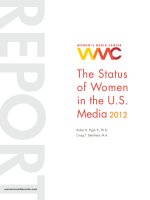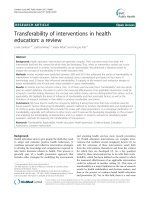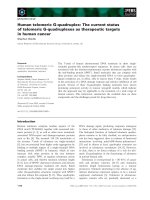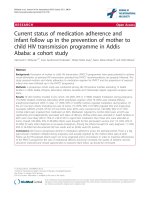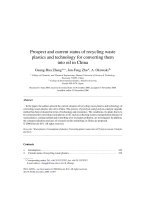Current status of mungbean in Madhya Pradesh - A review
Bạn đang xem bản rút gọn của tài liệu. Xem và tải ngay bản đầy đủ của tài liệu tại đây (221.77 KB, 11 trang )
Int.J.Curr.Microbiol.App.Sci (2018) 7(11): 1062-1072
International Journal of Current Microbiology and Applied Sciences
ISSN: 2319-7706 Volume 7 Number 11 (2018)
Journal homepage:
Review Article
/>
Current Status of Mungbean in Madhya Pradesh - A Review
Vinod Kumar* and S.K. Pandey
College of Agriculture, Powarkheda, Hoshangabad, Jawaharlal Nehru Krishi Vishwa
Vidyalaya - 461110 (MP), India
*Corresponding author
ABSTRACT
Keywords
Munbean, Production,
Disease, Intercropping
Article Info
Accepted:
10 October 2018
Available Online:
10 November 2018
Mungbean is one of important crop in India as well as India. Present review
is related to mungbean in Madhya Pradesh. Under this study is given the
information about farming and field preparation as well as weed
management. Also in this review mungbean disease and their control has
been studied including water management.
Introduction
Mungbean is the mature fruit seed of (Vigna
radiata L. Wilczek) cultivated in China more
than 2000 years, planted in many provinces as
crops in tropical and subtropical regions of the
Indian subcontinent and in South East Asian
countries like Thailand, Philippines, Vietnam,
Indonesia, Malaysia, South China and Korea.
India is the biggest producer of Mungbean
where about 3.83 million ha are cultivated
with 1.60 million tonne production (Annual
Report-AICRP on MULLaRP 2015-16).
Mungbean is excellent source of high quality
protein and mineral. The seeds have high
(28%) protein that is easily digestible, are easy
to cook and lack flatulence factors in contrast
to other legumes (Sahoo et al., 2003).
Mungbean is a rich source of protein (14.6–
33.0 g/100 g) and iron (5.9–7.6 mg/100 g)
(Dahiya et al., 2015). Mungbean contains 13% fat, 50.4% carbohydrates, 3.5-4.5% fibers
and 4.5-5.5% ash, while calcium and
phosphorus are 132 and 367 mg per 100 grams
of seed, respectively (Frauque et al., 2000).
Mungbean is consumed as whole grains,
sprouted form as well as dhal in a variety of
ways in homes. It is also used as green
manuring crop. Mungbean can be used as a
feed for cattle even husk of the seed can be
soaked in water and used as cattle feed. In
India these crops are cultivated in three
different seasons, viz., kharif, rabi and
summer. Summer Mungbean can be grown
after harvesting of chickpea, lentil, pea,
potato, mustard, wheat and cotton. Cultivation
of Jayad Mungbean is important to increase
1062
Int.J.Curr.Microbiol.App.Sci (2018) 7(11): 1062-1072
soil fertility in these areas where paddy –
wheat crop rotation is used.
Crop status of India
During Twelfth Plan (2012-2017): The total
area covered under mungbean in India was
34.50 lakh hectares with a total production of
15.91 lakh tonnes. The coverage of area and
its production was maximum in Rajasthan
(32.76% &30.61%) followed by Maharashtra
(11.95 % & 10.58%) of the total area and
production. Karnataka ranked third in area
(8.81%) and Tamilnadu is on third position for
production (7.63%). The highest yield was
recorded by the state of Punjab (845 kg/ha)
followed by Jharkhand (704 kg/ha) and
Andhra Pradesh (696 kg/ha). The National
yield average was 461 kg/ha. The lowest yield
observed in the state of Karnataka (227 kg/ha)
followed by C.G. (326 kg/ha) and Odisha (327
kg/ha). During the last three Plan Period area,
production
and
productivity
showed
increasing trend.
Crop status of Madhya Pradesh
In Madhya Pradesh during Twelfth Plan
(2012-2017) the total area covered under
Mungbean 2.51 lakh ha with 1.16 lakh tones
total production and productivity was 464
kh/ha (Annual Report DPD 2016-17).
Analysing the Madhya Pradesh state, the
mungbean crop, district Hoshangabad covered
maximum area i.e. 10.2 thousand hectare with
followed by Dhar with 7.062 and Chhatarpur,
Khargone, Satna and Rewa coverage around 6
thousand hectare. The highest production was
in Dhar i.e. 4.70 million tonnes with 7.3%
production tops in the state whereas
Hoshangabad with 4.32 million tonnes with
6.7% on second position and at third position
Khargone & Sidhi around 3 million tonnes.
The highest yield was recorded in Bhind 768
kh/ha followed by Ratlam 439 kg/ha, Dhar
420 kg/ha. The lowest yield was observed in
Mandla 50 kg/ha followed by Harda and
Dindori. District-wise area, production and
yield of top ten district of Madhya Pradesh in
respect of production, are presented below
which contributed 445% and 43.7% percent of
area and production of the state (Table 2).
Potential yield (FLD result)
It is observed that in general average potential
yield gap between FLD and farmer’s local
check yield is about 27%. The potential yield
level could be obtained by adoption of
improved package of practices. Front Line
Demonstration conducted on Mungbean crop
with improve variety SML 668 in Madhya
Pradesh the improve practice yield was 818
kg/ha and farmers yield was 600 kg/ha result
revealed the increase the yield over check 36.3
% (Source-ICAR-IIPR, Kanpur). From the
table 3, it is clearly visible that experimental
productivity is higher as compare to farmer
productivity for each variety. Based on the
above criteria for Madhya Pradesh is potential
state for production of mungbean. The state
occupies 2.5 lakh hectares and has potential
where productivity and production could be
increased by adoption of recent technologies.
In Madhya Pradesh, mungbean production can
be increased in five years by reducing 10%
yield gap every year.
Climate requirement
The crop needs a well-distributed rainfall,
high temperature, less humidity. Heavy rains
at flowering are harmful, even moist winds at
this stage interfere with fertilization. Water
logging is fatal for root development and
nitrogen fixation during early vegetative stage.
Crop is generally grown as rain fed but under
assured irrigation during summer in Indo
Gangetic plains of Northern India. The
additional importance of the seed/soil/water
contact zone in influencing sees germination
on soil (Fyfield and Gragory, 1989).
1063
Int.J.Curr.Microbiol.App.Sci (2018) 7(11): 1062-1072
Soil type and field preparation
Green gram can be grown on a variety of soils
ranging from sandy loam to black cotton soils
having good drainage capacity. Saline and
alkaline soils are not suitable for Mungbean
cultivation. Mungbean is very sensitive to
water logging conditions. A well prepared
seedbed is required for proper germination and
establishment of the crop. For this give 2 – 3
ploughings followed by planking to make the
seedbed free from clods and weeds. For the
summer/spring cultivation after the harvesting
of last crops, the tillage should be done after
irrigation. All land is suitable for Green gram
production with varying degrees of suitability
where 32.7%, 23.7% and 43.6% as highly,
moderately
and
marginally
suitable
respectively. Major limitations that prevent
land from being highly suitable include
acidity, alkalinity and poor drainage in soils
and in some cases steep slopes (Mugo JW et
al., 2016).
sugarcane seed rate should be 7-8 kg/ha. The
plant-to-plant distance should be maintained
(at least 5 cm). Sowing can be done behind the
local plough or with the help of seed drill. The
row spacing caused remarkable improvement
in growth attributes such as plant height, dry
matter accumulation, RGR, CGR and NAR at
different growth stages which resulted in
higher productivity (Mandal et al., 2012).
Seed treatment
Treat the seed with Thirum (2gm.)
+Carbendazim (1gm.) or Carbendazim &
Kepton (1gm. + 2gm) to control the soil &
seed germinated disease. For sucking pest
control seed treatment with Imidacloprid 70
WS @ 7g/ kg or Thiamethoxam 4g/kg seed. It
is also desirable to treat the seed with
Rhizobium and PSB culture (5-7gm/kg seed).
Biofertilizer significantly increase seed
germination and decrease incidence of foot
and root rot of Mungbean (Mohammad and
Hossan 2003).
Sowing time
Cropping systems
Mungbean should be sown during the first
week of July to last week of July. For the
summer or spring crop, Mungbean should be
sown after the harvest of last crop (potato,
sugarcane, mustard and cotton, etc). The
second fortnight of February to first fortnight
of March is most suitable for spring/summer
cultivation. Late sown Mungbean takes more
loss at the time of flowering stage due to high
temperature and yield affected. The early
planted crops produced higher yield as
compare to late planted crops (Rahman et al.,
2004).
Seed rate, spacing and method
During Kharif season 20 kg seed/ha should be
sown in rows 40-45 cm apart while during
Rabi and Summer 25 kg seed /ha sown in
rows 30 cm apart. As a companion crop with
The important crop rotations with moongbean
are given as under:
Rice-Wheat-Mung (summer), Maize + Mung –
Wheat - Mung, Maize (early) - Potato (early)wheat-Mung, Sugarcane+Mung (summer 1:2),
Cotton + Mung (1:3 in Central India 60/90 cm
paired row).
Intercropping
During kharif, mungbean are grown generally
with maize, pearl millet, pigeonpea and cotton
as intercrop. During spring, mungbean is
grown in 2:1 ratio with sugarcane with row to
row distance of 90 cm. and from mungbean 30
cm distance maintain. Intercropping with
sunflower is also suitable with ratio (2:6).
Intercropping of upland rice (Oryza sativa L.)
1064
Int.J.Curr.Microbiol.App.Sci (2018) 7(11): 1062-1072
with short-duration grain legumes has shown
promising productivity and resource use
efficiency (Aggarwal et al., 1990).
type & it’s availability or status in the soil.
Therefore, the doses of zinc should be applied
based on the soil type as follows:
Manure and fertilizer
Red sandy and loamy soils-2.5 kg Zn ha-1
(12.5 kg zinc sulphate hepta hydrate/ 7.5 kg
zinc sulphate mono hydrate) per hectare.
Mungbean is generally grown on the basic
fertility of soil. If available 8-10 tonnes of
compost or farm yard manure should be
applied before 15 days of sowing. For
mungbean, per hectare 15-20 kg nitrogen, 3040 kg phosphorus, 20 kg potash should be
applied at sowing time. The fertilizer should
be applied by drilling either at the time of
sowing or just before sowing in such a way
that they are placed about 2-3 cm below the
seed. The application of N and P fertilisers
significantly increased the see yield
(Sadeghipour et al., 2010).
Secondary and micro nutrients
Sulphur
In medium black soils and sandy loam soils
apply 20 kg S ha-1 (equivalent to 154 kg
gypsum/ phospho-gypsum/ or 22 kg bentonite
sulphur) as basal to each crop. If S deficiency
is diagnosed red sandy loam soils, apply 40 kg
S ha-1 (equivalent to 300 kg gypsum/phosphogypsum/or 44 kg bentonite sulphur) per
hectare. This quantity is sufficient for one crop
cycle. The application of sulphur @ 30 kg ha-1
significantly increased grain and stover yield
of Mungbean (Bahadur and Tiwari (2014)
(Table 1).
Black soils- 1.5 to 2.0 kg Zn ha-1 (7.5 to 10 kg
zinc sulphate hepta hydrate/ 4.5 to 6.0 kg zinc
sulphate mono hydrate) per hectare.
Laterite, medium and alluvial soils- 2.5 kg Zn
ha-1 (12.5 kg zinc sulphate hepta hydrate/ 7.5
kg zinc sulphate mono hydrate) as basal along
with 200 kg of farm yard manure.
High organic carbon containing Tarai soils-3.0
kg Zn ha-1 (15 kg zinc sulphate hepta hydrate/
9 kg zinc sulphate mono hydrate) as basal
once in three year.
Low organic carbon content and hilly sandy
loam soil - 2.5 kg Zn ha-1 (12.5 kg zinc
sulphate hepta hydrate/ 7.5 kg zinc sulphate
mono hydrate) as basal in every alternate year.
Boron
In B deficient soils, apply 0.5 kg B h-1 (5 kg
borax ha-1/ 3.6 kg di-sodium tetra borate penta
hydrate). The application of phosphorus and
boron has synergistic effect on yield, P and B
content in seed and straw of green gram
(Nidhi Kamboj and Malik, 2018).
Manganese
Zinc
The Application of 0.5% FeSO4 and ZnSO4 as
foliar spray (before flowering) along with
recommended doses of fertilizer in mungbean
for enhancement of production, quality and
upliftment of their socio-economic status
(Singh et al., 2013). Quantity of Zinc
requirement determined according to the soil
It is an activator of nitrite reductase and many
respiratory enzymes. It is necessary for the
evolution of oxygen (photolysis) during
photosynthesis. Functions with enzyme
systems
involved
in
breakdown
of
carbohydrates, and nitrogen metabolism. In
manganese deficient sandy loam soils, Seed
soaking with 2% manganese sulphate OR
1065
Int.J.Curr.Microbiol.App.Sci (2018) 7(11): 1062-1072
foliar spray of 1% manganese sulphate is
recommended.
Molybdenum
In molybdenum deficient soils, application of
0.5 kg Sodium Molybdate /ha as basal or two
foliar sprays of 0.1% Sodium Molybdate or
seed treatment is recommended.
Integrated pest management
Insect pests can attack mungbeans at any stage
from seedling to harvest but the crop is most
susceptible from budding onwards. It is
important to monitor crops once a week
during vegetative growth as the first buds are
borne below the top of the canopy.
Diseases
Water management
Yellow mosaic virus
Generally the kharif crop requires one life
saving irrigation, which may be applied during
the early pod formation stage. For the
summer/spring mungbean, 3–4 irrigations are
required. Apply first irrigation after 20-25
days of sowing and repeat after 10-15 days as
per need. One irrigation before flowering and
another at pod-filing stage would ensure
healthy seeds. Water logging in the field
should be avoided at all cost. No irrigation
should be given when the crop is in full bloom
stage.
Integrated weed management
Yield losses in Mungbean due to weeds have
been estimated to range between 30-50%
(Kumar et al., 2004). For effective weed
control use Pre- emergence herbicide @ 0.75
kg pendimetheline 30 EC + Imazethapyr 2 EC
with 600 liter water or 1lt ai fluclorelin with
800 liter water.
For post emergence the imazethapyr @ 0.075
kg/ ha applied 20-25 days after sowing was
the most remunerative and effective herbicide
for controlling the complex weed flora in
Mungbean (Khairnar et al., 2014).
Or the quizalofop-p-ethyl 50 g a.i. ha-1 at 21
day after emergence (DAE) + hand weeding
(HW) at 28 DAE (Kundu et al., 2009).
Always flat nozzle is used during spraying of
weedicide.
Symptoms
This disease is caused by the mungbean
yellow mosaic virus (MYMV) belonging to
Gemini group of viruses. The disease starts as
small yellow specks along the veinlets and in
severe form covers the entire lamina. Whitefly
(Bemisia tabaci) transmits this geminivirus in
the persistent (circulative) manner. The host
range is confined mostly to members of
the Leguminosae family. The economic losses
due to this virus account up to 85% in green
gram which is spreading faster towards newer
areas (Karthikeyan et al., 2014).
Control measure
Diseased plants should be rouged out to
prevent further spread of the disease. Seed
treatment with imidacloprid at 5 ml/kg seeds
and two sprays of imidacloprid at 0.5 ml/l at
25 and 40 days after sowing (DAS) or two
sprays of imidacloprid at 0.5 ml/l alone at 25
and 40 DAS were found effective in reducing
the incidence of MYMV and its vector. Seed
treatment with imidacloprid at 5 ml/kg seeds
plus two sprays of neemazal at 3 ml/l was also
effective in management of MYMV and its
vector (Jayappa et al., 2017). Grow
tolerant/resistant varieties like Meha, TJM-3,
PDM 139 (Samrat), PDM 11, PKV AKM-4,
HUM 2, IPM 02-14, MH 421, IPM 410-3
(Shikha) and IPM 205-7 (Virat).
1066
Int.J.Curr.Microbiol.App.Sci (2018) 7(11): 1062-1072
Crop status of Madhya Pradesh
District
HOSHANGABAD
DHAR
CHATTARPUR
KHARGONE
SATNA
REWA
SHIVPURI
SIDHI
TIKAMGARH
BARWANI
Area 000 ha
10.2
7.062
6.68
6.2776
6.184
6.02
5.59
5.56
5.36
5.3
District
DHAR
HOSHANGABAD
KHARGONE
SIDHI
SHIVPURI
CHATTARPUR
BARWANI
REWA
NARSINGHPUR
JABALPUR
Production MT
4.70
4.32
3.37
3.26
2.38
2.29
2.22
2.01
1.97
1.93
Table.1 Nutritive value
Protein
Fat
Minerals
Fiber
Carbohydrate
24-25%
1.3%
3.5%
4.1%
56%
Calcium
Phosphorus
Iron
Calorific value
Moisture
124 mg/100 g
326 mg/100 g
7.3 mg/100 g
334 Kcal/100 g
10%
Table.2 Recommended varieties for Madhya Pradesh
S.
No.
1.
Name of
variety
BM-4
Year of
Release
1992
Average
yield q/ha
10-12
Days to
Maturity
65-70
Reaction to major
diseases
Tol. To MYMV & PM
2.
JM-721
1995
12.4
70-75
Tol. To PM
3.
HUM 1
1999
9.0
65
Resistant to MYMV
4.
2000
9.0
60
Resistant to MYMV
5.
PUSA
9531
AKM 8802
2000
10-11
61-63
6.
PDM 139
2001
10-12
58-62
7.
Meha
2004
12-15
65-70
8.
TJM-3
2007
9.5
65
Moderately resistant to
MYMV
Highly resistant to
MYMV, Erect,
synchronous
Early maturity, MYMV
resistance
Resistant to MYMV, CLS
& PM
Resistant to MYMV
PKV
2009
10.0
62-66
AKM-4
IPM 410-3
2016
11-12
65-70
10.
(Shikha)
IPM 205-7
2016
10-11
52-56
11.
(Virat)
Source: - PC, AICRP on MULLaRP, Report 2016-17
9.
1067
Highly resistant to MYMV
and powdery mildew
Resistant to MYMV
Remark
Recommended for
Kharif
Recommended for
Kharif
Recommended for
Kkarif & summer
Recommended for
summer
Recommended for
Kharif
Recommended for
summer cultivation in
MP
Recommended for
summer cultivation
Recommended for
Kharif
Recommended for
Kharif
For Summer/
spring season
For Summer/
Season
Int.J.Curr.Microbiol.App.Sci (2018) 7(11): 1062-1072
Table.3 Experimental yield of dominating varieties (kg/ha)
S. No.
1.
2.
3.
Varieties
AKM 8802
PKV AKM 4
BM 4
2011-12
1696
2074
-
2012-13
1107
1448
1191
2013-14
634
315
833
2014-15
972
1326
878
2015-16
403
519
726
Mean
962.4
1136.4
725.6
Source- Annual Report AICRP on MULLaRP
Leaf curl
Anthracnose
Symptoms
Symptoms
The symptoms are visible first in third leaf
after three to four weeks of sowing. The
symptoms are downward curing of leaves
veinal necrosis, chlorotic spots and chlorosis
on the lamina, stunting and death of the plants
due to apical necrosis on green gram.
Symptoms are conformity with Nene (1972).
The affected plants, however, do not die till
the harvest of the crop.
Anthracnose caused by Colletotrichum
gloeosporioides is the causal organism
affecting aerial plant parts, however, the
leaves and pods are more vulnerable.
Control measures
Treat the seeds with imidacloprid 70 WS@
5ml/kg; Foliar spray of insecticide
(dimethoate 30 EC @ 1.7ml/ha) on 30 days
after sowing; Select resistant varieties
whenever possible i.e. SAMRAT (PDM 139),
PS 16; Leaf curl can be controlled by
applying sulfur or copper-based fungicides
that are labeled for use on peaches
and nectarines. For best results, trees should
be sprayed to the point of runoff or until they
start dripping; Containing copper and
pyrethrins, Bonide® Garden Dust is a safe,
one-step control for many insect attacks and
fungal problems; Keep the ground beneath the
trees raked up and clean, especially during
winter months; Prune and destroy infected
plant parts as they appear If disease problems
are severe, maintain tree health and vigor by
cutting back more fruit than normal, watering
regularly (avoiding wetting the leaves if
possible) and apply an organic fertilizers high
in nitrogen.
The characteristic symptoms of this disease
are circular brown sunken spots with dark
centers and bright red orange margins on
leaves and pods. Infection just after
germination causes seedling blight. The
average seed yield loss of 40.18 per cent and
stalk yield loss of 46.90 per cent was noticed
due to anthracnose of mungbean (Kulkarni,
2009).
Control measures
Hot water seed treatment at 580C for 15
minutes has been found effective in checking
the seed-borne infection and increasing
proportion of seed germination. The seed
treatment with Thiram 75 SD, 3 g/kg seeds +
two foliar sprays at 15 days interval starting
from initiation of disease with trifloxystrobin
+ tebuconazole (75 WG), 0.075 per cent or
with carbendazim + mancozeb (75WP), 0.075
percent (Chaudhari and Gohel 2016).
Cercospora leaf spot
Symptoms
It is most important fungal disease of
mungbean. Leaf spots are circular and
1068
Int.J.Curr.Microbiol.App.Sci (2018) 7(11): 1062-1072
irregular in shape with brown to greyishwhite centres and reddish-brown to dark
brown margins. Such spots are also visible or
pods are the affected pods become blackened.
Control measures
i) Field sanitation, crop rotation, destruction
of infected crop debris; ii) Opt for resistant
varieties as per recommendation of local
agricultural authorities (Like- LM 113, LM
168, LM 170, JM 171, Ganga 1, HUM 12,
Pusa 06722); iii) Treat the seeds with thiram
or captan @ 2.5g/kg of seed; iv) On
appearance of the symptoms spray with
carbendazim 50 WP @1.0 g/liter or mancoze
75 WP @ 2.0 g/liter or hexaconazole (contaf
5 % EC) @ 1 ml/ liter of water. Subsequent
spray should be done after 10 to 15 days, if
required. Spraying with copper oxychloride
@ 3 to 4 g /liter water has also been found
effective in management of the disease.
Control measures
i) Seed treated with Dimethoate 30 EC @
5ml/kg; ii) Foliar spray of Triazophos 40 EC
@ 2.0 ml/l or Malathion 50 EC @ 2.0 ml/l at
10-15 days intervals if required; iii) Grow
cotton as a trap crop one month earlier
between the mungbean rows; iv) Grow maize,
sorghum or pearl millet as a barrier crop to
minimize the incidence of whiteflies; v)
Install Sticky trap; vi) Opt. resistant varieties
e.g. ML 1256, ML 1260 and ML 1191
Bean thrips
Nature of damage
The thrips nymphs and adults feed on stigma
inside the flower, flower sheds before opening
and there is elongation of terminal shoot.
Plants attain a bushy growth and the crop
looks dark-green in colour, bearing few pods
with shrivelled grains.
Insect-pest management
Control measures
Numerous insect pests attack the mungbean.
The loss in the production caused by them
may reach up to 70% depending upon the
severity of attack. Some common insect pests
of mungbean and their management are as
follow:
White fly
Nature of damage
The infested plants become very weak
showing downward cupping of he leaves
giving a sickly look and the plant may die
Insect secretes honey dew on leaves results
blackening of leaves, drastically reducing
photosynthetic rate and drying of leaves.
Whitefly is a vector of number of viral
diseases especially mungbean yellow mosaic
virus (MYMV).
i) Seed treatment with Thiomethoxam 70 WS
@ 2 ml /kg seed + foliar spray of
Thiomethoxam 25 WG 0.2 g/liter of water of
is quite effective in controlling bean thrips; ii)
Spray neem seed kernel extract (50 g/l) and
neem oil 3000 ppm @ 20 ml/l; iii) Opt for
resistant varieties (Mungbean: PIMS 2, PMS
3, 12-333, Co 3, ML 5, ML 337; iv) Timely
irrigation at an interval of 15 days results in
low build-up of thrips; v) The incidence of
bean thrips can be minimized by
intercropping mungbean with cotton; vi)
Spray of Triazophos 40 EC @ 2.0 ml/liter,
Ethion 50 EC @ 2 ml/liter of water.
Stem fly
Nature of damage
Stem fly (Ophiomyia phaseoli) maggots mine
the leaves or bore into the leaf petiole or
1069
Int.J.Curr.Microbiol.App.Sci (2018) 7(11): 1062-1072
tender stem resulting in withering, drooping
and death of plant. The characteristic
symptoms of damage include drooping of the
first two leaves and yellowing of plants. It can
cause 5 – 20% damage in mungbean.
Control measures
i) Follow clean cultivation, crop rotation,
earthing up, growing trap crop, destroying
alternative hosts like Solanum nigrum to
minimize the stem fly incidence; ii) Opt for
resistant varieties (Mungbean: CoGG 912 &
CoGG 917; Urdbean: CoBG 671 & AC 222);
iii) Seed soaking either in imidacloprid 17.8
SL @ 5.0 ml/kg seed in 100 ml water for one
hour or thiomethoxam 25 WG @ 5.0 g/kg
seed in 100 ml water to avoid early incidence
of stem fly is recommended; iv) Spray either
Imidacloprid 17.8 SL @ 0.2ml/l or
thiomethoxam 25 WG @ 0.3g/lit at 15 days
after sowing.
Bihar hairy caterpillar
Harvesting threshing and storage
Mung should be harvested when more than 80
per cent pods mature. One or two rounds of
picking of pods are also recommended to
avoid losses due to shattering. The plants are
cut with the sickle and dried on the threshing
floor. These are then threshed by beating with
sticks or by trampling with bullocks.
The clean seeds should be sun dried for 3-4
days to bring their moisture content at 8-10%
to safely store in appropriate bins.
Yield
A well-managed crop, as indicated above,
may produce 8-10 quintals and in mixed crop
yield 3-5 quintals grains per ha. In rainy
season crop produce 10 qtls/ha and in summer
crop produce 12-15 qtls. /ha. In mixed
cropping 3-5 qtls/ha.
Recommendation
production
to
achieved
higher
Nature of damage
Deep summer ploughing once in 3 years.
Female moths lay eggs on plants in a field.
Young caterpillar eats away all the green
matter of the leaves and it can be easily
recognized by perforated, dusty white
coloured leaves in the field. The grown-up
caterpillars feed voraciously on leaves, soft
stems and branches. The insect totally denude
the crop within few days resulting in total
failure of the crop.
Control measures
i) Uproot the damaged plants along with the
young larvae at the gregarious phase and
burry under the soil; ii) Spray of Quinalphos
25 EC @ 2.5 ml/liter or Dichlorvos 10 EC@
1.0 ml/ liter or Fenvalerate 20 EC @ 1.87 ml/
liter of water or dusting with Fenvalerate
0.4% @ 15 kg/ha.
Seed treatment should be done before sowing.
Application of fertilizer should be based on
soil test value.
In kharif season sowing should be done by
ridge & furrow method.
Yellow mosaic resistant/ tolerant varieties
Narendra Mung1, Pant Mung 3, PDM 139
(Samrat), PDM 11, MUM 2, ML 337, IPM
02-14, MH 421, SML 832 etc. choose as per
suitability of region.
Weed control should be done at right time.
Adopt integrated
protection.
1070
approach
for
plant
Int.J.Curr.Microbiol.App.Sci (2018) 7(11): 1062-1072
Global supplies of pulses are limited, as India
happens to be the largest producer and
consumer of pulses. India needs around 32
million tons of pulses by 2030, to feed the
estimated population of about 1.68 billion.
Hence, India needs to produce the required
quantity, but also remain competitive to
protect
indigenous
pulses
including
mungbean production. Improved technologies
like improved, high yielding varieties and
appropriate crop management practices are
available. However, great efforts by farmers,
researchers, and government agencies are
there to ensure that India becomes selfsufficient in pulses in the next coming years.
The programs initiated by the government are
bearing fruits, and it is hoped that this
momentum is sustained and strengthened to
make India self-sufficient in pulses. During
the last three Plan Period area fluctuating,
however, production and productivity showed
increasing trend. The yield of most of the
potential districts were below the National
average yield need to be adopt Improved
Package of Practices of the Mungbean to
increase the production in districts as well as
state and country.
References
Aggarwal,
P.
K., D.
P. Garrity, S.
P. Liboon and R. A. Morris (1990).
Resource Use and Plant Interactions in a
Rice-Mungbean Intercrop. Agronomy
Journal. 84 (1), p. 71-78
Annual
Report
DPD
2016-17DPD/Pub/TR/19/2016-17
Chaudhari, Kinjal A. and N. M. Gohel
(2016). Management of anthracnose
disease of mungbean through new
fungicidal formulations. Journal of Pure
and Applied Microbiology, 10(1), P.
691-696.
Dahiya, P. K., A. R. Linnemann, M. A. J. S.
Van Boekel, N. Khetarpaul, R. B.
Grewal and M. J. R. Nout Mung Bean:
Technological and Nutritional Potential.
Crit Rev Food Sci Nutr. 2015; 55
(5):670-88.
Frauque, A., T. Haraguchi, O. Hirota, and M.
A. Rahman (2000). Growth analysis,
yield, and canopy structure in maize,
mungbean intercropping. Bu. Inst. of
Tropical Agric. Kyushu University
Fukuoka, Japan, 23: 61-69.
Fyfield, T. P. and P. J. Gragory (1989) Effects
of Temperature and Water Potential on
Germination, Radicle Elongation and
Emergence of Mungbean. Journal of
Experimental Botany. 40 (6), Pp 667–
674.
Jayappa, HK Ramappa and BD Devamani
(2017). Management of Mungbean
Yellow Mosaic Virus (MYMV) in
Mungbean (Vigna radiata L.). Journal
of Entomology and Zoology Studies,
5(5): 596-601.
Kamboj, Nidhi and R.S. Malik (2018)
Influence of Phosphorus and Boron
Application on Yield, Quality, Nutrient
Content and Their Uptake by Green
Gram (Vigna radiate L.). Int. J. Curr.
Microbiol. App. Sci 7(3): 1451-1458.
Karthikeyan, A., V.G. Shobhana, M. Sudha,
M. Raveendran, N. Senthil, M.
Pandiyan and P. Nagarajan (2014)
Mungbean yellow mosaic virus
(MYMV): a threat to green gram (Vigna
radiata)
production
in
Asia.
International
Journal
of
Pest
Management, 60:4, 314-324.
Khairnar, C.B., V.V. Goud and H.N. Sethi
(2014). Pre- and post-emergence
herbicides for weed management in
mungbean. Indian Journal of Weed
Science 46(4): 392–395.
Kulkarni, S. A. (2009). Epidemiology and
integrated management of anthracnose
of green gram. M.Sc. (Agri.) Thesis
submitted
to
UAS,
Dharwad,
Karnataka.
1071
Int.J.Curr.Microbiol.App.Sci (2018) 7(11): 1062-1072
Kumar R, Thakral SK and Kumar S. 2004.
Response of mungbean (Vigna radiate
L.) to weed control and fertilizer
application under different planting
system. Indian Journal of Weed Science
36: 131-132.
Kundu, R., P. S. Bera and K. Brahmachari
(2009). Effect of different weed
management practices in summer
mungbean [Vigna radiata L.] under new
alluvial zone of West Bengal. Journal of
Crop and Weed, 5(2): 117-121.
Lal Bahadur and D.D. Tiwari (2014). Nutrient
Management in Mung Bean (Vigna
radiata L.) Through Sulphur and
Biofertilizers. Legume Res., 37 (2): 180
– 187.
Mandal J., R, Mallick and H. Banerjee
(2012). Growth and yield of green gram
(Vigna radiata) as affected by rowspacing and foliar application of
nutrients. Research on Crops.13(2):525528·
Mohammad, D. and I. Hossain (2003). Seed
Treatment
with
Biofertilizer
in
Controlling Foot and Root Rot of
Mungbean. Plant Pathology Journal, 2:
91-96.
Mugo, J. W., P.C Kariuki and M. D. K
Musembi (2016). Identification of
Suitable Land for Green Gram
Production Using GIS Based Analytical
Hierarchy Process in Kitui County,
Kenya. Journal of Remote Sensing &
GIS. ISSN: 2469-4134.
Nene YL. Disease of mung and urd bean. 4.
Leaf curl in Nene YL (ed.). A survey of
viral diseases of pulse crops in Uttar
Pradesh, University Press, Pantnagar,
India. 1972, 142-153.
Rahman Md. A. S., Md. H. Kabir, M.
Begum and Md. A. Salam (2004). Yield
Performance of Mungbean as Affected
by Planting Date, Variety and Plant
Density. Journal of Agronomy.3 (1): 1824,
Sadeghipour, O., R. Monem and A.A. Tajali
(2010). Production of Mungbean (Vigna
radiata L.) as Affected by Nitrogen and
Phosphorus Fertilizer Application.
Journal of Applied Sciences, 10: 843847.
Sahoo, L., Sugla, T. and Jaiwal, P.K. In vitro
regeneration
and
genetic
transformations of Vigna species. In
Jaiwal, P.K., Singh, R.P. (eds.)
Biotechnology for the improvement of
legumes.
Kluwer
Acad
Publ,
Netherlands, 2003; pp. 1-48.
Singh, Vijayata , R. K. Yadav, Rajesh Yadav,
R. S Malik, N. R. Yadav, Jogendra
Singh and M. D. Meena (2013). Effect
of different iron and zinc application on
growth, yield and quality parameters of
mungbean (Vigna radiata L.). Annals of
Agri Bio Research. 18 (2), pp.164-175.
How to cite this article:
Vinod Kumar and Pandey, S.K. 2018. Current Status of Mungbean in Madhya Pradesh - A
Review. Int.J.Curr.Microbiol.App.Sci. 7(11): 1062-1072.
doi: />
1072

